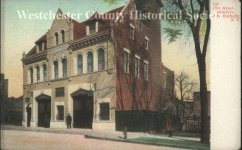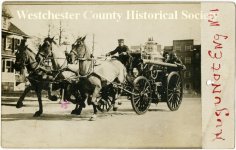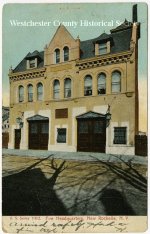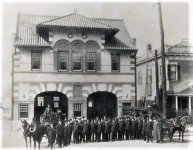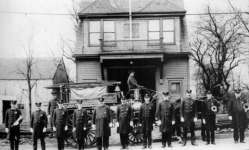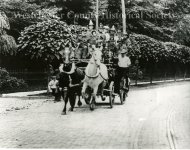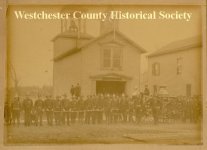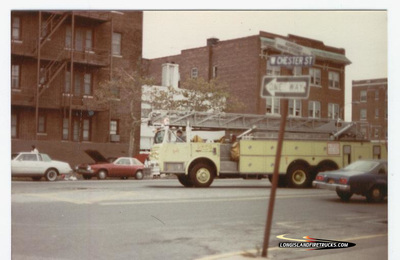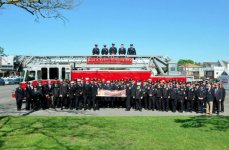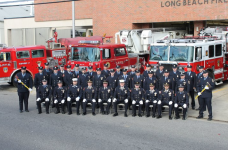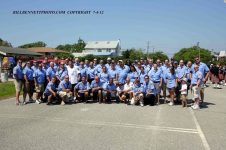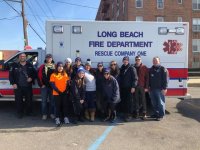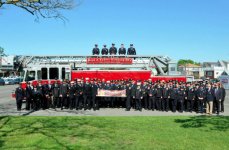You are using an out of date browser. It may not display this or other websites correctly.
You should upgrade or use an alternative browser.
You should upgrade or use an alternative browser.
FIRE DEPARTMENTS IN NY STATE
- Thread starter mack
- Start date
LONG BEACH

Organized 1929

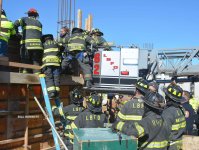
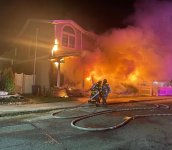
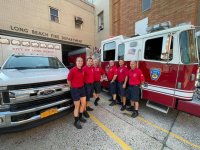
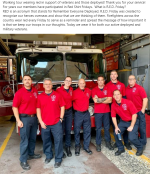
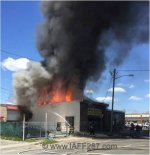
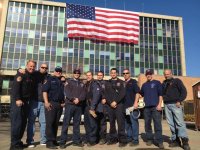

 www.facebook.com
www.facebook.com

Organized 1929








Long Beach Professional Fire Fighters | Long Beach NY
Long Beach Professional Fire Fighters, Long Beach. 6,413 likes · 194 talking about this · 126 were here. To provide the highest quality of fire, rescue and emergency medical service to the citizens &...
 www.facebook.com
www.facebook.com
Last edited:
LONG BEACH
LBFD History

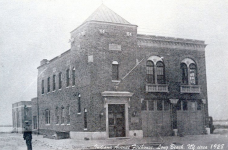
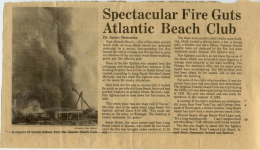
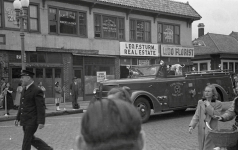
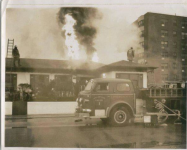
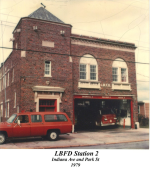

 longbeachfd.com
longbeachfd.com
LBFD History







Gallery – Long Beach Fire Department
The men and women of the City of Long Beach, NY Fire Department work hard every day to provide the residents and visitors of Long Beach with the best possible emergency response possible. The members take pride in being a part of a fire department with a rich history and a true commitment to...
UTICA FIRE DEPARTMENT

The Utica Fire Department (UFD) protects 63,000 residents within 17.5 square miles inclusive with four Engine companies, two Truck companies, one light rescue (Tactical or Tac Unit), three ambulances (Rescues), and an on-duty deputy chief. The total complement is 123 members. There are four deputy chiefs; one deputy chief for each of the four platoons. Minimum daily staffing is 23 firefighters and officers (captains and lieutenants). All members with the exception of the fire chief are members of the International Association of Firefighters (IAFF) Local 32 and the New York State Professional Fire Fighters Association (NYSPFFA).

Fire Chief
Scott E. Ingersoll

Fire Stations
Fire Station 1
1522 Whitesboro Street (West Side)
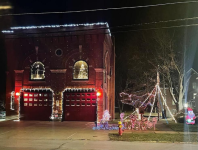
Engine 1 - 2012 Sutphen Monarch (1500/500) (SN#HS-5048)
Engine 11 (Antique) - 1949 American LaFrance 700 series open cab
Fire Station 2 - Headquarters
552 Bleecker Street (Downtown)

Car 1 (Chief) - 2021 Ford Explorer AWD
Car 2 (Assistant Fire Chief) - 2009 Chevrolet Tahoe 4x4
Car 3 (Reserve Deputy Chief) - 2005 Chevrolet Silverado 4x4
Car 4 (Deputy Chief) - 2017 Ford F-350 4x4
Car 5 (Chief Fire Marshal) - 2017 Ford Taurus
Truck 2 - 2017 Sutphen SPH100 (1500/300/100' mid-mount platform)
Rescue 2 - 2018 Ford F-550 / Sutphen
Truck 3 (Reserve) - 2018 Sutphen SL75 (1500/500/75' mid-mount)
Squad 7 (Personnel Carrier) - 2001 Ford F-450 Bus
Unit 7 (Fire Marshal) - 2017 Ford
Unit 11 (Fire Mechanic) - 2016 Ford F-350 4x4 utility body
Fire Station 3
1501 Mohawk Street (East Side)
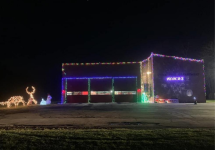
Engine 3 - 2019 Sutphen Monarch (1500/750)
HazMat 1 - Ford F-350 4x4 / Knapheide
HazMat 2 - 2009 Chevrolet Suburban 4x4
UTV 1 - 2008 John Deere Gator
HazMat Trailer - 2018 35' Cargo Mate walk in trailer
Foam Trailer - 2014 National Foam trailer (NYS owned)
Special Hazards Co. Trailer - (Used for storage)
Mass Casualty Incident (MCI) - Trailer (Owned by Oneida County)
Engine 6 (Reserve) - 1997 HME / Ferrara Spartan (1500/500) (Ex-Engine 4/Tac 1)
Fire Station 4
29 Shepherd Place (South Side)
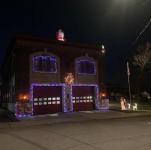
Truck 1 - 2012 Sutphen SL100 (1500/300/100' mid-mount)
Engine 4 (Reserve) - 2001 Seagrave (1500/500/30F) (SN#78A21) (Ex-Engine 5)
Fire Station 5 - 415 Van Rensselaer Road (North Side)
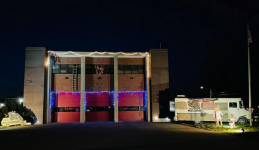
Engine 5 - 2018 Sutphen Monarch (1500/750)
Squad 8 - (Fire Investigation Unit) - 201? Ford F-350 box truck
Engine 2 - (Reserve) 2001 Seagrave (1500/500)
Ambulance 3 (Reserve) - 2013 Ford E-450
Ladder 4 - (Reserve) - 1995 Sutphen (?/?/104' mid mount) (Ex-Rocky Hill Fire Department (Connecticut))
Fire Station 7
1217 Park Avenue (Oneida Square)
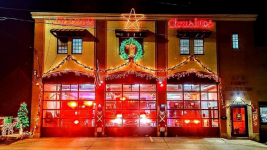
Engine 7 - 2008 Pierce Arrow XT (1500/500) (SN#20160) (Ex-Engine 3)
Ambulance 1 - 2019 Ford E-450
Ambulance 2 - 2020 Ford E-450
Ambulance 4 - 2018 Ford E-450
Ambulance 5 - 2017 Ford E-450
Engine and Truck companies are normally staffed with one officer and two firefighters; the Tac Unit is staffed with one officer and one firefighter; Rescue 1 is staffed with two firefighter-paramedics, and Rescues 2 and 3 are crossed staffed with members of Engine 7. The citywide shift commander (Car 204) is a deputy chief.
All fire companies are New York State (NYS) certified Advanced Life Support (ALS) first responders with at least one firefighter-paramedic at all times. Rescue companies are staffed with two firefighter-paramedics. Truck Company 1 and Tac Unit 2 carry hydraulic rescue equipment (Jaws of Life), air bags, cribbing, and other extrication equipment. The Utica Fire Department has provided first response Basic Life Support (BLS) and ALS services since 1980; furthermore, since August of 2005, the Utica Fire Department is the primary Emergency Medical Services (EMS) transport provider for the City of Utica. The Utica Fire Department is the largest provider of EMS in the Midstate (Oneida, Herkimer, and Madison County Upstate NY) region, because over 80 of our firefighters are paramedics.


The Utica Fire Department (UFD) protects 63,000 residents within 17.5 square miles inclusive with four Engine companies, two Truck companies, one light rescue (Tactical or Tac Unit), three ambulances (Rescues), and an on-duty deputy chief. The total complement is 123 members. There are four deputy chiefs; one deputy chief for each of the four platoons. Minimum daily staffing is 23 firefighters and officers (captains and lieutenants). All members with the exception of the fire chief are members of the International Association of Firefighters (IAFF) Local 32 and the New York State Professional Fire Fighters Association (NYSPFFA).
Fire Department
cityofutica.com

Fire Chief
Scott E. Ingersoll

Fire Stations
Fire Station 1
1522 Whitesboro Street (West Side)

Engine 1 - 2012 Sutphen Monarch (1500/500) (SN#HS-5048)
Engine 11 (Antique) - 1949 American LaFrance 700 series open cab
Fire Station 2 - Headquarters
552 Bleecker Street (Downtown)

Car 1 (Chief) - 2021 Ford Explorer AWD
Car 2 (Assistant Fire Chief) - 2009 Chevrolet Tahoe 4x4
Car 3 (Reserve Deputy Chief) - 2005 Chevrolet Silverado 4x4
Car 4 (Deputy Chief) - 2017 Ford F-350 4x4
Car 5 (Chief Fire Marshal) - 2017 Ford Taurus
Truck 2 - 2017 Sutphen SPH100 (1500/300/100' mid-mount platform)
Rescue 2 - 2018 Ford F-550 / Sutphen
Truck 3 (Reserve) - 2018 Sutphen SL75 (1500/500/75' mid-mount)
Squad 7 (Personnel Carrier) - 2001 Ford F-450 Bus
Unit 7 (Fire Marshal) - 2017 Ford
Unit 11 (Fire Mechanic) - 2016 Ford F-350 4x4 utility body
Fire Station 3
1501 Mohawk Street (East Side)

Engine 3 - 2019 Sutphen Monarch (1500/750)
HazMat 1 - Ford F-350 4x4 / Knapheide
HazMat 2 - 2009 Chevrolet Suburban 4x4
UTV 1 - 2008 John Deere Gator
HazMat Trailer - 2018 35' Cargo Mate walk in trailer
Foam Trailer - 2014 National Foam trailer (NYS owned)
Special Hazards Co. Trailer - (Used for storage)
Mass Casualty Incident (MCI) - Trailer (Owned by Oneida County)
Engine 6 (Reserve) - 1997 HME / Ferrara Spartan (1500/500) (Ex-Engine 4/Tac 1)
Fire Station 4
29 Shepherd Place (South Side)

Truck 1 - 2012 Sutphen SL100 (1500/300/100' mid-mount)
Engine 4 (Reserve) - 2001 Seagrave (1500/500/30F) (SN#78A21) (Ex-Engine 5)
Fire Station 5 - 415 Van Rensselaer Road (North Side)

Engine 5 - 2018 Sutphen Monarch (1500/750)
Squad 8 - (Fire Investigation Unit) - 201? Ford F-350 box truck
Engine 2 - (Reserve) 2001 Seagrave (1500/500)
Ambulance 3 (Reserve) - 2013 Ford E-450
Ladder 4 - (Reserve) - 1995 Sutphen (?/?/104' mid mount) (Ex-Rocky Hill Fire Department (Connecticut))
Fire Station 7
1217 Park Avenue (Oneida Square)

Engine 7 - 2008 Pierce Arrow XT (1500/500) (SN#20160) (Ex-Engine 3)
Ambulance 1 - 2019 Ford E-450
Ambulance 2 - 2020 Ford E-450
Ambulance 4 - 2018 Ford E-450
Ambulance 5 - 2017 Ford E-450
Engine and Truck companies are normally staffed with one officer and two firefighters; the Tac Unit is staffed with one officer and one firefighter; Rescue 1 is staffed with two firefighter-paramedics, and Rescues 2 and 3 are crossed staffed with members of Engine 7. The citywide shift commander (Car 204) is a deputy chief.
All fire companies are New York State (NYS) certified Advanced Life Support (ALS) first responders with at least one firefighter-paramedic at all times. Rescue companies are staffed with two firefighter-paramedics. Truck Company 1 and Tac Unit 2 carry hydraulic rescue equipment (Jaws of Life), air bags, cribbing, and other extrication equipment. The Utica Fire Department has provided first response Basic Life Support (BLS) and ALS services since 1980; furthermore, since August of 2005, the Utica Fire Department is the primary Emergency Medical Services (EMS) transport provider for the City of Utica. The Utica Fire Department is the largest provider of EMS in the Midstate (Oneida, Herkimer, and Madison County Upstate NY) region, because over 80 of our firefighters are paramedics.

NewYorkStateFire.com - Utica Fire Department station and apparatus information
Fire and EMS department information and weblinks for stations in the city of Utica, New York.
www.newyorkstatefire.com
Last edited:
UTICA FIRE DEPARTMENT
History
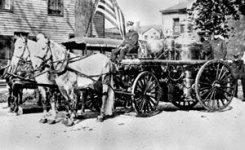

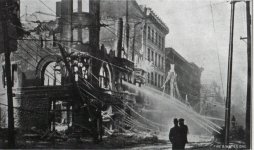
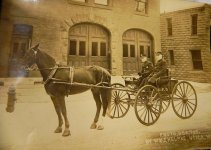
The Utica Fire Department was motorized in 1917 and the new machines were put on display in this photo taken on Broad Street. Prior to this the department had used horses to pull the engines and the horses were the pride of the firemen.
Early on, fire engines were hand operated but in 1864 the city purchased two new "steam" engines. This heavy apparatus had to be drawn to the fires by members of the company to which it was assigned, and the men were exhausted by the time they reached the scene of the fire.
The city decided to contract with a livery stable to furnish a team of horses to pull the steamers. This would cause a delay and often the teams furnished had no experience hauling a fire engine. The city then decided to purchase its own horses which pulled the steams and the heavy ladder trucks which were added to the fleet.
Fire horses required much stamina, strength and natural ability. Their training took between one and two years and they were able to tell the difference between a real and a practice drill. When they saw the men run to the indicator box and the drivers run to the engine, they knew it was the real thing.
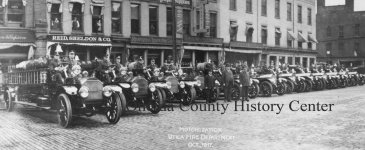
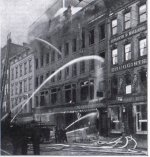
1920s
1930s

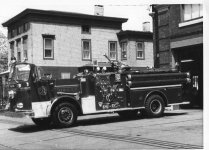
History




The Utica Fire Department was motorized in 1917 and the new machines were put on display in this photo taken on Broad Street. Prior to this the department had used horses to pull the engines and the horses were the pride of the firemen.
Early on, fire engines were hand operated but in 1864 the city purchased two new "steam" engines. This heavy apparatus had to be drawn to the fires by members of the company to which it was assigned, and the men were exhausted by the time they reached the scene of the fire.
The city decided to contract with a livery stable to furnish a team of horses to pull the steamers. This would cause a delay and often the teams furnished had no experience hauling a fire engine. The city then decided to purchase its own horses which pulled the steams and the heavy ladder trucks which were added to the fleet.
Fire horses required much stamina, strength and natural ability. Their training took between one and two years and they were able to tell the difference between a real and a practice drill. When they saw the men run to the indicator box and the drivers run to the engine, they knew it was the real thing.


1920s
1930s


Last edited:
UTICA FIRE DEPARTMENT
UFD Fires

 www.youtube.com
www.youtube.com
YFD Responding
https://www.youtube.com/watch?v=v_8_QPYZCNg&list=PLc8Eu9t5RdVc1iCVsETkva5tkg94uqy0j&index=4
https://www.youtube.com/watch?v=pX1Sytzvb-E&list=PLc8Eu9t5RdVc1iCVsETkva5tkg94uqy0j&index=1
UFD Fires

Bleecker Street Fire - Utica, NY (December 1996)
Utica Mayor Ed Hanna called this "the most poorly conducted firefighting project that anybody should be subjected to,” adding that he thought it was a shamef...
YFD Responding
https://www.youtube.com/watch?v=v_8_QPYZCNg&list=PLc8Eu9t5RdVc1iCVsETkva5tkg94uqy0j&index=4
https://www.youtube.com/watch?v=pX1Sytzvb-E&list=PLc8Eu9t5RdVc1iCVsETkva5tkg94uqy0j&index=1
Last edited:
UTICA FIRE DEPARTMENT
Apparatus
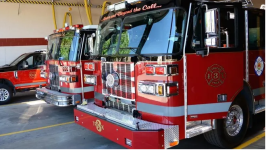
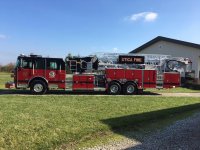
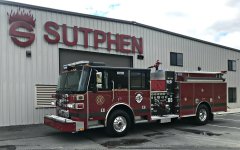
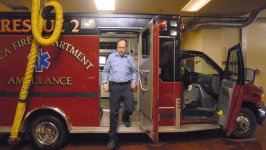
Dispatching
Dispatching is done by Oneida County Enhanced 911 emergency services. The Utica Fire Department responds to an average of 12,500 alarms per year. Emergency medical calls account for approximately 10,000 of those calls, with the remainder being fire and other emergency calls.

HAZMAT
Hazardous material (HAZMAT) emergencies are handled by the UFD’s HAZMAT team, operating out of Station 3. The HAZMAT team utilizes two specialized trailers pulled by two 2005 Chevy pickup trucks, respectively. The Utica Fire Department also provides HAZMAT response to the entire eastern half of Oneida County and all of Herkimer County.
Apparatus
| Utica Fire Department Apparatus | ||||
| Engines | Ladders | Rescues | Chief's Units | Others |
| Engine 1 | Truck 1 | Tactical Unit 2 | Hazmat Command | |
| Engine 3 | Tower 2 | Rescue 4 | ||
| Engine 4 |




Dispatching
Dispatching is done by Oneida County Enhanced 911 emergency services. The Utica Fire Department responds to an average of 12,500 alarms per year. Emergency medical calls account for approximately 10,000 of those calls, with the remainder being fire and other emergency calls.

HAZMAT
Hazardous material (HAZMAT) emergencies are handled by the UFD’s HAZMAT team, operating out of Station 3. The HAZMAT team utilizes two specialized trailers pulled by two 2005 Chevy pickup trucks, respectively. The Utica Fire Department also provides HAZMAT response to the entire eastern half of Oneida County and all of Herkimer County.
UTICA FIRE DEPARTMENT

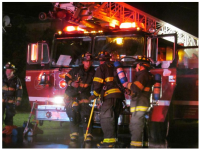
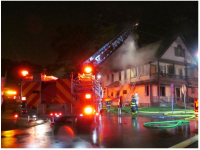
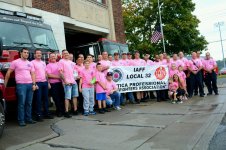
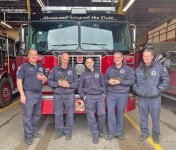
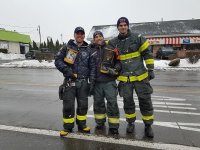
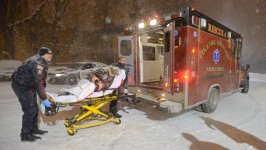
UFD Line of Duty Deaths
Firefighter John O'Hanlon 9/26/1897
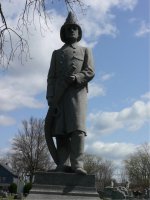
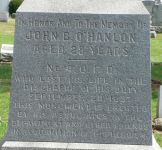
28 years old. Died at a Utica fire. Assigned to Engine 4.
Firefighter Charles E. Owens 2/6/1907
Deputy Chief William F. Acquaviva 1/15/2001

 www.firerescue1.com
www.firerescue1.com
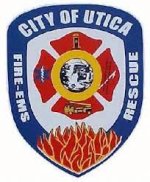







UFD Line of Duty Deaths
Firefighter John O'Hanlon 9/26/1897


28 years old. Died at a Utica fire. Assigned to Engine 4.
Firefighter Charles E. Owens 2/6/1907
Deputy Chief William F. Acquaviva 1/15/2001
Video: Utica Firefighters Save 4-Year-Old Girl From Fire

Video: Firefighters save 4-year-old girl from fire
The firefighters were honored for their harrowing rescue

Last edited:
WHITE PLAINS
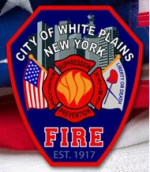
The White Plains Fire Department (WPFD) protects the City of White Plains, a city with a population of 60,000 residents in an area of about 10 square miles.
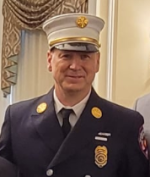
Fire Chief
Douglas McMath
It is comprised of the following units:
Fire Stations

Fire Station 1
93 Prescott Avenue (Highlands)
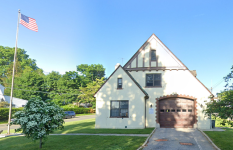
Engine 65 - 2016 Freightliner / Smeal (1250/750/20F) (Ex-Engine 70)
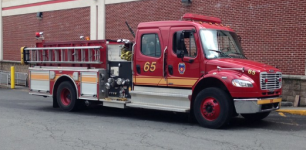
Fire Station 2 / Maintenance Division
20 Ferris Avenue (Downtown)
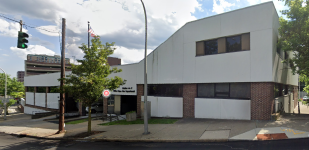
Engine 66 - 2016 Freightliner / 2018 Smeal (1250/750/20F)
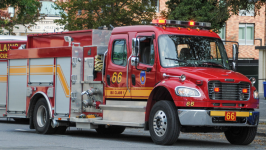
Tower Ladder 6 - 2018 Spartan Gladiator Classic / Smeal (-/-/100' mid-mount platform)
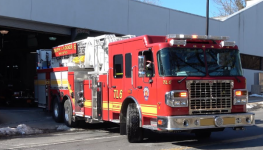
Mini Attack 32 - 2001 Ford F-350 4x4 (350/200)
Squad 4 - 2004 Pierce Saber walk-around rescue (SN#15350) (Ex-Rescue 88)
Utility Unit 2 - 2005 Ford F-350 4x4
Engine 68 (Spare) - 2004 Freightliner / Pierce Contender (1250/500) (Ex-Engine 67)
Engine 72 (Spare) - 2003 Freightliner / American LaFrance (1250/750) (Ex-Engine 70, ex-Engine 71)
Ladder 33 (Spare) - 2007 American LaFrance (-/-/110' LTI rear-mount) (Ex-Ladder 34, ex-Ladder 32)
Spare - 2005 Freightliner / Pierce Contender (1250/750) (Ex-Engine 65)
Fire Station 3
2 Terrace Avenue (East Side)

Engine 67 - 2009 Freightliner M2 / Smeal (1250/750) (Ex-Engine 66)
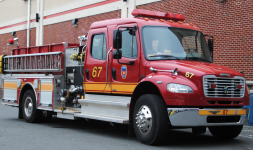
Engine 69 (Spare) - 2004 Freightliner / Pierce Contender (1250/750) (Ex-Engine 65)

The White Plains Fire Department (WPFD) protects the City of White Plains, a city with a population of 60,000 residents in an area of about 10 square miles.

Fire Chief
Douglas McMath
It is comprised of the following units:
- 5 Firehouses
- 5 Engine Companies (65, 66, 67, 70, 71)
- 3 Ladder Companies
- 2x 105' rear-mount aerials (32, 34)
- 1x 100' mid-mount platform (6)
- 1 Rescue Company (88)
- 1 Deputy
- Deputy (Tour Commander)
Fire Stations

Fire Station 1
93 Prescott Avenue (Highlands)

Engine 65 - 2016 Freightliner / Smeal (1250/750/20F) (Ex-Engine 70)

Fire Station 2 / Maintenance Division
20 Ferris Avenue (Downtown)

Engine 66 - 2016 Freightliner / 2018 Smeal (1250/750/20F)

Tower Ladder 6 - 2018 Spartan Gladiator Classic / Smeal (-/-/100' mid-mount platform)

Mini Attack 32 - 2001 Ford F-350 4x4 (350/200)
Squad 4 - 2004 Pierce Saber walk-around rescue (SN#15350) (Ex-Rescue 88)
Utility Unit 2 - 2005 Ford F-350 4x4
Engine 68 (Spare) - 2004 Freightliner / Pierce Contender (1250/500) (Ex-Engine 67)
Engine 72 (Spare) - 2003 Freightliner / American LaFrance (1250/750) (Ex-Engine 70, ex-Engine 71)
Ladder 33 (Spare) - 2007 American LaFrance (-/-/110' LTI rear-mount) (Ex-Ladder 34, ex-Ladder 32)
Spare - 2005 Freightliner / Pierce Contender (1250/750) (Ex-Engine 65)
Fire Station 3
2 Terrace Avenue (East Side)

Engine 67 - 2009 Freightliner M2 / Smeal (1250/750) (Ex-Engine 66)

Engine 69 (Spare) - 2004 Freightliner / Pierce Contender (1250/750) (Ex-Engine 65)
WHITE PLAINS
Fire Station 6 / Fire Headquarters225 Mamaroneck Avenue (Downtown)
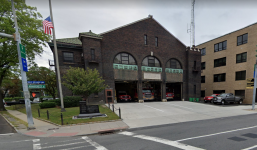
Engine 70 - 2020 Spartan ERV Metro Star (1250/750)
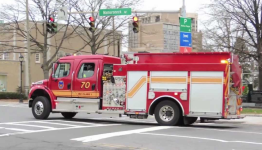
Ladder 32 - 2016 Spartan Gladiator Classic / Smeal (-/-/105' rear-mount)

Rescue 88 - 2020 Spartan Gladiator Classic EMFD 6x4 / SVI walk-around (SN#1132)
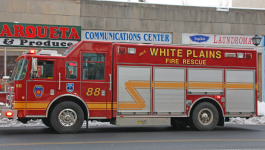
Car 2512 (Deputy Chief) - 2015 Ford Expedition 4x4
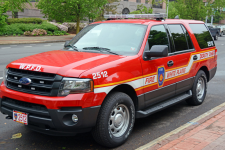
Fire Station 7
665 North Street (Ridgeway)
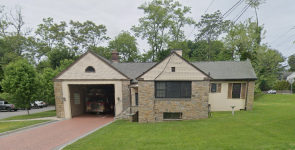
Engine 71 - 2009 Freightliner M2 106 / Smeal (250/750/20F) (SN#3771) (Ex-Engine 70)
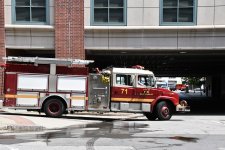
Ladder 34 - 2012 Spartan Gladiator Classic / Smeal (-/-/105' rear-mount) (Ex-Ladder 32)
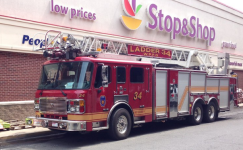
Fire Station 4 Special Operations Division / Administrative Offices
32 South Lexington Avenue (Downtown)
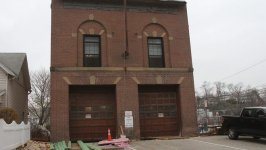
Car 2510 - 2005 Ford Expedition 4x4 (Ex-Car 2512)
Car 2513 - 2013 Ford Escape
Car 2514 - 2004 Chrysler PT Cruiser
Car 2515 - 2005 Ford Escape
Car 2516 - 2007 Ford Escape
Car 2517 (Fire Prevention Unit 1) - 2014 Ford Escape
Car 2518 - 2020 Ford F-350 4x4
Utility 1 (Collapse Rescue Unit) - 1991 Ford / Ward 79 / 2006 FD-Built (Ex-Engine 73)
Storage Facility
Harding Avenue & Robertson Avenue (Battle Hill)
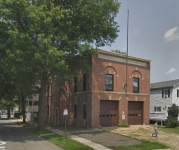
Engine 210 (Antique) - 1969 Maxim (1000/500) (Ex-Engine 68, ex-Engine 69)
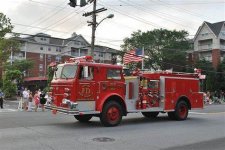
Apparatus

White Plains - Station 2
Engine 66, Tower Ladder 6, Squad 4, Squad Support Unit 4, Mini Attack 32, Utility 2, Spare Engines 68, 69, 72 and 73, Spare Ladder 33
public.fotki.com
WHITE PLAINS
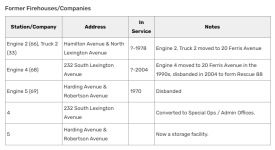
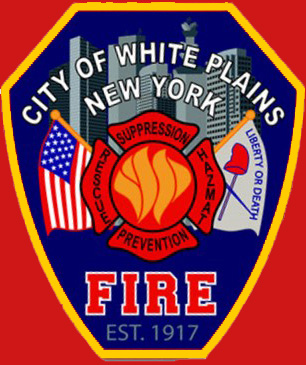
 fire.fandom.com
fire.fandom.com
Fire Suppression is the largest division within the Fire Bureau and staffs five fire stations located throughout the city. The Division provides fire suppression, rescue and hazardous material services.
There are four groups in the division, each managed by a Deputy Chief. Suppression is charged with responding to alarms of fire, performing suppression functions, and assuring complete extinguishment.
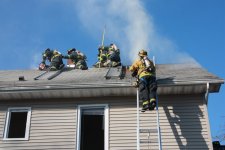
The priorities of Fire Suppression are life safety, incident stabilization and property preservation. Fire Suppression members participate in daily inspections, fire safety educational programs and numerous other fire-related duties. Engine and Ladder Companies are normally staffed with a minimum of three personnel.
The Fire Suppression Division has four groups that work to provide emergency response 24 hours a day – 7 days a week. The Division staffs five (5) Engine companies, three (3) Truck companies and one (1) Rescue company.
 whiteplainspublicsafety.com
whiteplainspublicsafety.com
The Fire Prevention Division strives to reduce the loss of life and property by fire through code enforcement, inspections and public education.
Daily inspections are conducted on multi-family residences, commercial and retail buildings with the purpose of providing a safer environment.
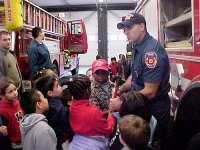
Fire suppression companies inspect properties and re-inspection of properties are completed by Fire Prevention personnel in order to provide continuity in enforcement practices.
In most cases when safety violations are found they are corrected within a short time, for those who neglect or refuse to comply they are prosecuted in City Court. The Bureau’s inspection program requires that all occupancy owners annually test and inspect their fire detection and suppression systems as per NFPA standards. In addition, Fire Prevention does most of the final inspection of Detection and Suppression systems for new construction and renovations.
Education and certification for fire inspectors is extensive. Inspectors must successfully complete the New York State Basic Code Enforcement Training Series. The State requires Code Enforcement Officers to complete six Basic Training Courses: “Introduction to Code Enforcement Practices”, “Inspection Procedures for Existing Structures”, “General Construction Principles”, “Residential Code of New York State” and “Building Code of New York State”. A comprehensive competency examination is given at the end of each of these courses. Completion of all six courses qualifies an individual to do fire code and building construction inspections.
New York State Code Enforcement Officers are required to maintain their certification by attending 24 hours of training and education annually. These programs are sponsored by the New York State Building Officials Conference or New York State Fire Marshals and Inspectors associations.
The Fire Prevention Bureau provides a wealth of education about how to prevent fire and what to do in the event of a fire. The Bureau provides programs in schools, senior and civic associations, business groups and the news media to create public awareness of the hazards of fire.
The plan review lieutenant approves site sprinkler systems plans and detection and suppression system plans for code compliance with State and Local Fire and Building Codes. The plan review lieutenant also conducts on-site inspections and system testing of fire protection equipment. A close working relationship is maintained between the plan review lieutenant and Building Department personnel meeting regularly to review building plans for various fire safety systems. Upon request information is provided to architects and contractors concerning matters of code requirements and fire safety.
 whiteplainspublicsafety.com
whiteplainspublicsafety.com
Special Operations is responsible for training and emergency planning.
Special Operations operates the training facilities to simulate actual fire and rescue emergencies and plans joint training exercises for the Police and Fire Bureaus. The division encompasses the Fire Bureaus Rescue Unit, the Hazardous Materials Unit and a Rescue Medical Team (RMT).
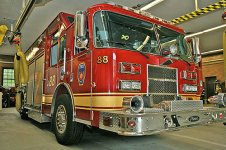
 whiteplainspublicsafety.com
whiteplainspublicsafety.com
History
A brief history of White Plains Firefighters
By Barbara Carlson
White Plains Historical Society
A White Plains fire engine speeds by, sirens blazing, responding to a call. This scene is always an exciting one, as the spotless engine and the outfitted firemen inside convey rapid response, efficiency and professionalism. An emergency is being handled with confidence and care.
Fires have always occurred, so one would assume that fire departments, in some form, have always been around. This, however, is not always the case, and White Plains is no exception.
The first volunteer company in the White Plains Fire Department was organized on December 2, 1851, after a disastrous fire at “Crawford’s Hotel” which stood on South Broadway in the vicinity of the Court House (the present day Armory); this was the Hope Engine Company No. 1 . In 1854, after a fire destroyed the “Orawaupum House,” donations were collected to purchase the first engine for the Village. Known as “Old Hope” it was custom made and cost $1200.00, an expensive sum at the time. The Company eventually disbanded in 1874 but was reorganized in 1883. Information from 1886 describes this Company occupying a building at the corner of Hamilton and Lexington Avenues; the building “has a fire tower, seventy feet high, in which twelve lengths of hose can be dried at once. In this tower is the fire bell which is used to alarm the people in case of fire. The company numbers about thirty-eight members.” Also, shortly after 1886, the water supply system and fire hydrants were installed.
The Union Hook and Ladder Company No. 1 was organized in May, 1861. It disbanded in May, 1876 but was reorganized in 1883; it had about fifty members. Independent Engine No. 2 was organized in 1884, and this company numbered about forty members. White Plains Firefighters Barbara Carlson Page 2 Fire Patrol No. 1 was formed in December, 1895 with 10 members, to control and protect property at fire scenes.
Three additional companies were formed and are still in existence, consisting of East Side Hose (Engine) Company No. 3 organized in December, 1897; South Side Engine Company No. 4 in October, 1906; and Chatterton Hose (Engine) Company No. 5 in October, 1907.
Between 1907 and 1917, a number of “disastrous” fires took place in the city, in which buildings were destroyed and firemen were injured or killed. These fires, together with the fact that many of the volunteer firemen were leaving to serve in World War One, and White Plains officially becoming a city, resulted in the hiring of the first paid firemen. From the first hired in April, 1917 to April, 1927, forty-four paid firemen were appointed under civil service. Several paid firemen were each assigned to the volunteer companies. H. Abbott Griffen, head of the volunteers since 1914, was appointed chief of the paid department; he would serve until his retirement in July, 1950. And two years after the first paid men were in the department, the Firemen’s Pension Fund was started, with all members of the department participating. In 1929, the Uniformed Firemen’s Benevolent Association was organized for the purpose of taking care of members and their families in times of sickness or death.
On September 20, 1924, the Gedney Farms Hotel caught on fire and was destroyed; White Plains “suffered its first million-dollar fire”. This disaster was largely due to an inadequate water supply, and the city then installed a new and extremely well-regarded water supply system.
Modern equipment meant motorized trucks and thus horses were replaced. One article reported that “… we regretted to lose our horses -- they meant so much to us. ‘Nip’ and ‘Tuck’ found new homes which we carefully chose where their treatment would always be of the best.”
In 1927, White Plains built a new fire station headquarters at Mamaroneck Avenue and Maple Avenue where it still is today. The continued growth of the city necessitated a second paid company, which was placed in service as Engine Company No. 6 in January, 1932; the department had now grown to 75 paid men and officers. The department continued to grow until World War II started in 1941. Then, firemen left to serve in the military, and the volunteers filled in. They augmented the paid firemen at night by “sleeping in” at the various fire houses.
After the war, the growth of the city in the southeastern areas required more protection, and in 1950, a new station was built at the corner of North Street and Ridgeway, housing Engine Company No. 7. It is still in use today.
As White Plains has continued to expand its population, the need for volunteer firefighters has also continued. Currently there are six companies in the Volunteer Fire Division: Hope Engine, Union Hook & Ladder, Fire Patrol, East Side Engine, South Side Engine and Chatterton Engine; with a combined total of approximately 100 members. The primary role of the Division is to support the Fire Department in an ancillary/supplementary capacity. They are trained in fire safety, search and rescue, emergency preparedness, basic first aid and emergency sheltering.
The Volunteer Division is headquartered at Fire Station 5, at the corner of Robertson and Harding Avenues, just off Central Avenue. Members of the Division undergo training as and are members of CERT (Community Emergency Response Teams), a component of FEMA. The goal is to increase local neighborhood self-sufficiency during emergencies. The Volunteer Division played a significant role during Hurricanes Irene and Sandy. During Sandy they staffed and ran an emergency shelter for 12 days and in addition canvassed neighborhoods throughout the city to ascertain the condition of and communicate information to residents who were without power. They also assisted in staffing a shelter for 45 individuals who were displaced as the result of the YMCA fire in September, 2013. Last March, during the major snow storm, the Volunteer’s ran the city’s warming center for 9 days and assisted manning a fire watch at 86 Dekalb Ave., when the building was without power.
White Plains is grateful for this group of dedicated volunteer firefighters. Look for them marching in our city’s parades and if you are interested in participating in the volunteer fire service, please contact the office of the Chief of the Fire Department, or 1st Assistant Chief Robert Amadio.
Thanks to Ben Himmelfarb of the White Plains Public Library, Bob Amadio of the White Plains Fire Department – Volunteer Division and Elaine Massena, City Archivist for their assistance with this article
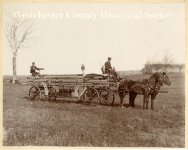
Horse-drawn fire engine, Union Hook and Ladder Company No. 1
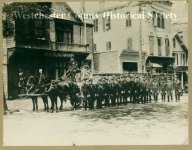
Union Hook & Ladder Fire Department headquarters, Grand Street - horse-drawn engine
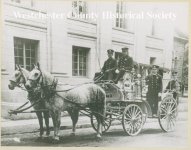
East Side Hose Company horse-drawn fire engine, on Court Street

Fire on Orawaupum Street, April 16, 1908
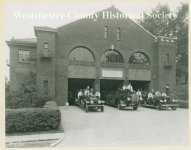
Fire headquarters, Mamaroneck Avenue and Maple Avenue


Ladder 2
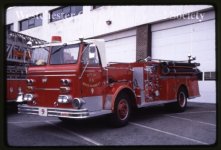
Engine 9 at Station 2
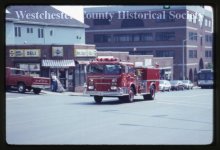
White Plains Fire Department fire engine - looking west on Post Road at Cromwell Place


White Plains Fire Department (New York)
The White Plains Fire Department has an ISO Class 1 rating. The White Plains Fire Department (WPFD) protects the City of White Plains, a city with a population of 60,000 residents in an area of about 10 square miles. It is comprised of the following units: 5 Firehouses 5 Engine Companies (65...
Fire Suppression is the largest division within the Fire Bureau and staffs five fire stations located throughout the city. The Division provides fire suppression, rescue and hazardous material services.
There are four groups in the division, each managed by a Deputy Chief. Suppression is charged with responding to alarms of fire, performing suppression functions, and assuring complete extinguishment.

The priorities of Fire Suppression are life safety, incident stabilization and property preservation. Fire Suppression members participate in daily inspections, fire safety educational programs and numerous other fire-related duties. Engine and Ladder Companies are normally staffed with a minimum of three personnel.
The Fire Suppression Division has four groups that work to provide emergency response 24 hours a day – 7 days a week. The Division staffs five (5) Engine companies, three (3) Truck companies and one (1) Rescue company.
Fire Suppression – White Plains Public Safety
 whiteplainspublicsafety.com
whiteplainspublicsafety.com
The Fire Prevention Division strives to reduce the loss of life and property by fire through code enforcement, inspections and public education.
Daily inspections are conducted on multi-family residences, commercial and retail buildings with the purpose of providing a safer environment.

Fire suppression companies inspect properties and re-inspection of properties are completed by Fire Prevention personnel in order to provide continuity in enforcement practices.
In most cases when safety violations are found they are corrected within a short time, for those who neglect or refuse to comply they are prosecuted in City Court. The Bureau’s inspection program requires that all occupancy owners annually test and inspect their fire detection and suppression systems as per NFPA standards. In addition, Fire Prevention does most of the final inspection of Detection and Suppression systems for new construction and renovations.
Education and certification for fire inspectors is extensive. Inspectors must successfully complete the New York State Basic Code Enforcement Training Series. The State requires Code Enforcement Officers to complete six Basic Training Courses: “Introduction to Code Enforcement Practices”, “Inspection Procedures for Existing Structures”, “General Construction Principles”, “Residential Code of New York State” and “Building Code of New York State”. A comprehensive competency examination is given at the end of each of these courses. Completion of all six courses qualifies an individual to do fire code and building construction inspections.
New York State Code Enforcement Officers are required to maintain their certification by attending 24 hours of training and education annually. These programs are sponsored by the New York State Building Officials Conference or New York State Fire Marshals and Inspectors associations.
The Fire Prevention Bureau provides a wealth of education about how to prevent fire and what to do in the event of a fire. The Bureau provides programs in schools, senior and civic associations, business groups and the news media to create public awareness of the hazards of fire.
The plan review lieutenant approves site sprinkler systems plans and detection and suppression system plans for code compliance with State and Local Fire and Building Codes. The plan review lieutenant also conducts on-site inspections and system testing of fire protection equipment. A close working relationship is maintained between the plan review lieutenant and Building Department personnel meeting regularly to review building plans for various fire safety systems. Upon request information is provided to architects and contractors concerning matters of code requirements and fire safety.
Fire Prevention – White Plains Public Safety
 whiteplainspublicsafety.com
whiteplainspublicsafety.com
Special Operations is responsible for training and emergency planning.
Special Operations operates the training facilities to simulate actual fire and rescue emergencies and plans joint training exercises for the Police and Fire Bureaus. The division encompasses the Fire Bureaus Rescue Unit, the Hazardous Materials Unit and a Rescue Medical Team (RMT).

Special Operations – White Plains Public Safety
 whiteplainspublicsafety.com
whiteplainspublicsafety.com
History
A brief history of White Plains Firefighters
By Barbara Carlson
White Plains Historical Society
A White Plains fire engine speeds by, sirens blazing, responding to a call. This scene is always an exciting one, as the spotless engine and the outfitted firemen inside convey rapid response, efficiency and professionalism. An emergency is being handled with confidence and care.
Fires have always occurred, so one would assume that fire departments, in some form, have always been around. This, however, is not always the case, and White Plains is no exception.
The first volunteer company in the White Plains Fire Department was organized on December 2, 1851, after a disastrous fire at “Crawford’s Hotel” which stood on South Broadway in the vicinity of the Court House (the present day Armory); this was the Hope Engine Company No. 1 . In 1854, after a fire destroyed the “Orawaupum House,” donations were collected to purchase the first engine for the Village. Known as “Old Hope” it was custom made and cost $1200.00, an expensive sum at the time. The Company eventually disbanded in 1874 but was reorganized in 1883. Information from 1886 describes this Company occupying a building at the corner of Hamilton and Lexington Avenues; the building “has a fire tower, seventy feet high, in which twelve lengths of hose can be dried at once. In this tower is the fire bell which is used to alarm the people in case of fire. The company numbers about thirty-eight members.” Also, shortly after 1886, the water supply system and fire hydrants were installed.
The Union Hook and Ladder Company No. 1 was organized in May, 1861. It disbanded in May, 1876 but was reorganized in 1883; it had about fifty members. Independent Engine No. 2 was organized in 1884, and this company numbered about forty members. White Plains Firefighters Barbara Carlson Page 2 Fire Patrol No. 1 was formed in December, 1895 with 10 members, to control and protect property at fire scenes.
Three additional companies were formed and are still in existence, consisting of East Side Hose (Engine) Company No. 3 organized in December, 1897; South Side Engine Company No. 4 in October, 1906; and Chatterton Hose (Engine) Company No. 5 in October, 1907.
Between 1907 and 1917, a number of “disastrous” fires took place in the city, in which buildings were destroyed and firemen were injured or killed. These fires, together with the fact that many of the volunteer firemen were leaving to serve in World War One, and White Plains officially becoming a city, resulted in the hiring of the first paid firemen. From the first hired in April, 1917 to April, 1927, forty-four paid firemen were appointed under civil service. Several paid firemen were each assigned to the volunteer companies. H. Abbott Griffen, head of the volunteers since 1914, was appointed chief of the paid department; he would serve until his retirement in July, 1950. And two years after the first paid men were in the department, the Firemen’s Pension Fund was started, with all members of the department participating. In 1929, the Uniformed Firemen’s Benevolent Association was organized for the purpose of taking care of members and their families in times of sickness or death.
On September 20, 1924, the Gedney Farms Hotel caught on fire and was destroyed; White Plains “suffered its first million-dollar fire”. This disaster was largely due to an inadequate water supply, and the city then installed a new and extremely well-regarded water supply system.
Modern equipment meant motorized trucks and thus horses were replaced. One article reported that “… we regretted to lose our horses -- they meant so much to us. ‘Nip’ and ‘Tuck’ found new homes which we carefully chose where their treatment would always be of the best.”
In 1927, White Plains built a new fire station headquarters at Mamaroneck Avenue and Maple Avenue where it still is today. The continued growth of the city necessitated a second paid company, which was placed in service as Engine Company No. 6 in January, 1932; the department had now grown to 75 paid men and officers. The department continued to grow until World War II started in 1941. Then, firemen left to serve in the military, and the volunteers filled in. They augmented the paid firemen at night by “sleeping in” at the various fire houses.
After the war, the growth of the city in the southeastern areas required more protection, and in 1950, a new station was built at the corner of North Street and Ridgeway, housing Engine Company No. 7. It is still in use today.
As White Plains has continued to expand its population, the need for volunteer firefighters has also continued. Currently there are six companies in the Volunteer Fire Division: Hope Engine, Union Hook & Ladder, Fire Patrol, East Side Engine, South Side Engine and Chatterton Engine; with a combined total of approximately 100 members. The primary role of the Division is to support the Fire Department in an ancillary/supplementary capacity. They are trained in fire safety, search and rescue, emergency preparedness, basic first aid and emergency sheltering.
The Volunteer Division is headquartered at Fire Station 5, at the corner of Robertson and Harding Avenues, just off Central Avenue. Members of the Division undergo training as and are members of CERT (Community Emergency Response Teams), a component of FEMA. The goal is to increase local neighborhood self-sufficiency during emergencies. The Volunteer Division played a significant role during Hurricanes Irene and Sandy. During Sandy they staffed and ran an emergency shelter for 12 days and in addition canvassed neighborhoods throughout the city to ascertain the condition of and communicate information to residents who were without power. They also assisted in staffing a shelter for 45 individuals who were displaced as the result of the YMCA fire in September, 2013. Last March, during the major snow storm, the Volunteer’s ran the city’s warming center for 9 days and assisted manning a fire watch at 86 Dekalb Ave., when the building was without power.
White Plains is grateful for this group of dedicated volunteer firefighters. Look for them marching in our city’s parades and if you are interested in participating in the volunteer fire service, please contact the office of the Chief of the Fire Department, or 1st Assistant Chief Robert Amadio.
Thanks to Ben Himmelfarb of the White Plains Public Library, Bob Amadio of the White Plains Fire Department – Volunteer Division and Elaine Massena, City Archivist for their assistance with this article

Horse-drawn fire engine, Union Hook and Ladder Company No. 1

Union Hook & Ladder Fire Department headquarters, Grand Street - horse-drawn engine

East Side Hose Company horse-drawn fire engine, on Court Street

Fire on Orawaupum Street, April 16, 1908

Fire headquarters, Mamaroneck Avenue and Maple Avenue


Ladder 2

Engine 9 at Station 2

White Plains Fire Department fire engine - looking west on Post Road at Cromwell Place
WHITE PLAINS

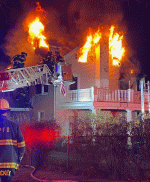

 www.facebook.com
www.facebook.com
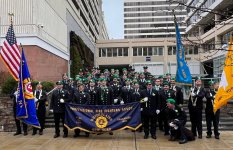
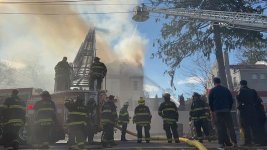
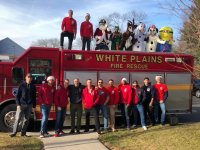
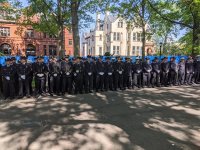
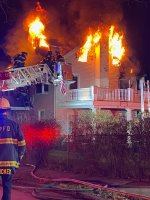
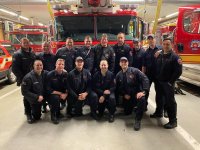
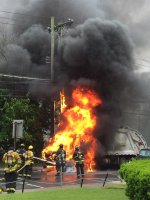
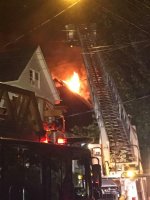



White Plains Professional Fire Fighters - IAFF Local 274
White Plains Professional Fire Fighters - IAFF Local 274, White Plains, New York. 4,784 likes · 40 talking about this · 15 were here. http://whiteplainsfire.org
 www.facebook.com
www.facebook.com








WHITE PLAINS
Companies Responding
Fires
https://www.youtube.com/watch?v=NkATSNGToqg
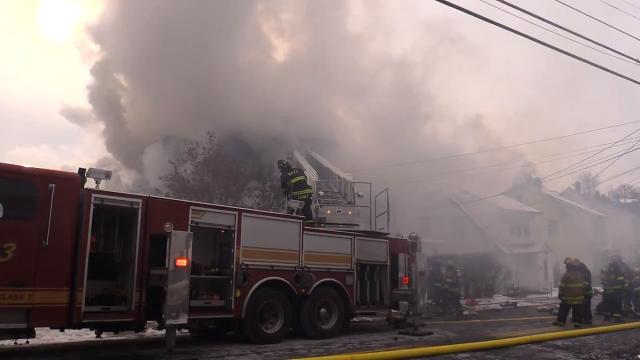
 www.lohud.com
www.lohud.com
https://www.youtube.com/watch?v=w3IE8Pj8PbU
Rescue

 www.youtube.com
www.youtube.com
Recruiting
Illustrated Guide for CWP Fire Agility Test (PDF)
Fire Fighter Agility Handbook (PDF)
Conditions for Military Make-Up (PDF)
FAQ's / Military Candidates (PDF)
MILITARY APPLICANTS ONLY If you are active military and interested in applying after the filing period, you should submit an e-mail request along with your most recent Military Orders and/or DD214 as soon as possible after discharge to: cburkart@whiteplainsny.gov, to see if you qualify for a special accommodation.
 www.cityofwhiteplains.com
www.cityofwhiteplains.com

Companies Responding
Fires
https://www.youtube.com/watch?v=NkATSNGToqg

Video: Firefighters battle White Plains house fire
Firefighters work to put out a house fire on Park Avenue in White Plains, Dec. 31, 2017.
https://www.youtube.com/watch?v=w3IE8Pj8PbU
Rescue

Watch: Off-Duty New York Fireman Saves Woman From Burning Car
Nicholas Perri Jr., a fireman from White Plains, New York, was driving home through Brookfield, Connecticut, when he saw someone waving for help and the burn...
Recruiting
Fire Fighter
The next City of White Plains Fire Fighter exam is anticipated to be held in March of 2025 (unless otherwise announced). Please look for exam announcements in local newspapers and on this website in the Fall of 2024.Documents & Resources
Fire Fighter Written Exam Study Guide (PDF)Illustrated Guide for CWP Fire Agility Test (PDF)
Fire Fighter Agility Handbook (PDF)
Conditions for Military Make-Up (PDF)
Frequently Asked Questions - Fire Fighter Exam
FAQ's / Fire Fighter ExamFAQ's / Military Candidates (PDF)
MILITARY APPLICANTS ONLY If you are active military and interested in applying after the filing period, you should submit an e-mail request along with your most recent Military Orders and/or DD214 as soon as possible after discharge to: cburkart@whiteplainsny.gov, to see if you qualify for a special accommodation.
Fire Fighter | White Plains, NY - Official Website
Exam and requirement information for firefighter candidates.

WHITE PLAINS
LODDsWhite Plains Firefighters Memorial Monument
219 Mamaroneck Avenue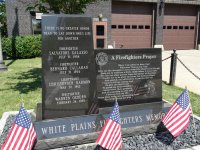
Located on the property of White Plains Fire Headquarters, the monument, made of black Zimbabwean granite, was erected and designed under the supervision of the White Plains firefighters, and currently honors four professional firefighters killed in the line of duty: Salvatore N. Galasso and Bernard J. Callahan who both perished on July 31, 1954; Lieutenant Christopher Harmon who perished on May 30, 1962; and Warren Ogburn, who perished on February 24, 1988. The monument also contains the well-known poem “A Firefighter’s Prayer,” written in 1947 by Smokey Linn.Firefighter Salvatore Galasso
White Plains Fire Department
July 31, 1954
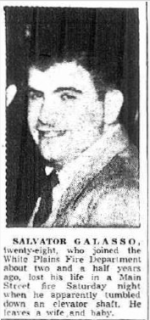

Firefighter Bernard Callahan
White Plains Fire Department
July 31, 1954
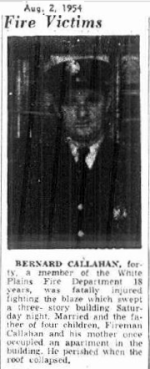
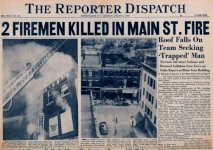
Lieutenant Christopher Harmon
White Plains Fire Department
May 30, 1962
Lt Christopher Harmon died from a massive heart attack in the line of duty. He was 48 years old.
Firefighter Warren R Ogburn, 39
White Plains Fire Department. White Plains, New York
February 24, 1993 - LODD
Firefighter Ogburn was trapped on 8th floor elevator, questionable whether breathing apparatus had depleted air. The cause of death was asphyxiation from smoke inhalation.
Lt. Clark Douglass
White Plains Fire Department
Jul 26, 2018

Retired NY fire Lt. dies of 9/11-related illness
Retired, 53, was one of 60 members of his department who assisted the FDNY after the World Trade Center attacksJul 26, 2018
By FireRescue1 Staff
WHITE PLAINS, N.Y. — A retired fire lieutenant died Saturday of a 9/11-related illness.
Lohud.com reported that retired White Plains Fire Department Lt. Clark Douglass, 53, was one of around 60 members of his department who went to help FDNY in rescue and recovery efforts after the World Trade Center attacks.

Retired White Plains Fire Department Lt. Clark Douglass, 53, was one of around 60 members of his department who went to help FDNY in rescue and recovery efforts after the World Trade Center attacks.
According to Patch.com, Douglass retired in March due to his illness after a 30-year fire career.
The Douglass family has a long-standing tradition in the fire service. Douglass’ grandfather and brother were firefighters, his father was a deputy chief and his nephew is currently a firefighter as well.
Douglass leaves behind his wife, JoAnn and three children.
Deputy Chief Edward John CioccaWhite Plains Fire Department
May 1, 2020

Chief Ciocca was exposed to COVID-19 during on-duty activities. He became ill and his health worsened. He died on May 1, 2020, as a result of COVID-19 complications.
Deputy Fire Chief Edward J. Ciocca was a third generation firefighter who proudly served the community for 35 years. His father, Deputy Fire Chief Adelmo Ciocca served the community from 1954-1992 and his grandfather Chief Edward J. McDonald, was Fire Chief of the White Plains Fire Department from 1950 – 1958.
Attachments
NEW ROCHELLE
The New Rochelle Fire Department provides fire protection and fire extinguishment services, initiating life rescue, rendering emergency medical assistance, controlling hazardous material situation including weapons of mass destruction incidents and providing related emergency services. The Fire Department administers and enforces the prevention code and the housing code, the City's contracted ambulance service, and promotes prevention activities designed to reduce the incidence and probability of fire.
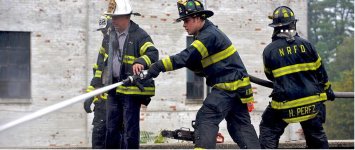
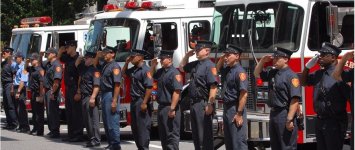
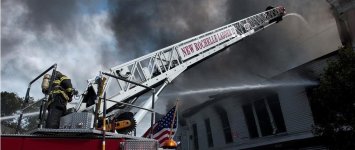
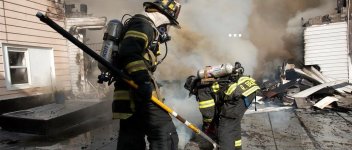
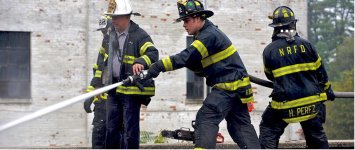
 www.newrochelleny.com
www.newrochelleny.com

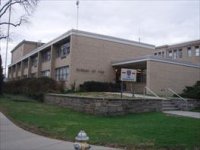
Overview
Fire Headquarters serves as the Fire Department's administrative offices building. Our offices are located in the former police headquarters, which was built in 1962.
The Fire Department has had offices in this building since it opened, but after the new police court complex was built, the Department consolidated all offices to this location.
Facilities
Offices for the Fire Commissioner, Code Enforcement, Support Service, Fire Prevention, Training, Safety, EMS, and the Office of Emergency Management are located within headquarters.
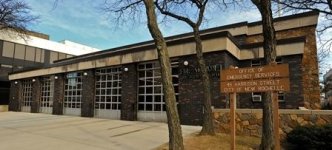
Overview
Station #1 is the largest fire house in New Rochelle. It was built in 1966 as a combination fire station and civil defense air raid control station.
Apparatus
This station houses five major vehicles, many support vehicles, and the Fire Department maintenance shop.
Staff
Approximately 50 firefighters and officers are assigned in four shifts to man this station.
The New Rochelle Fire Department provides fire protection and fire extinguishment services, initiating life rescue, rendering emergency medical assistance, controlling hazardous material situation including weapons of mass destruction incidents and providing related emergency services. The Fire Department administers and enforces the prevention code and the housing code, the City's contracted ambulance service, and promotes prevention activities designed to reduce the incidence and probability of fire.





Fire Department | New Rochelle, NY
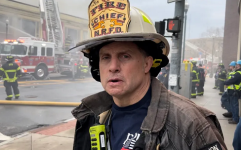
Fire Chief
Andrew Sandor
Fire Headquarters

Overview
Fire Headquarters serves as the Fire Department's administrative offices building. Our offices are located in the former police headquarters, which was built in 1962.
The Fire Department has had offices in this building since it opened, but after the new police court complex was built, the Department consolidated all offices to this location.
Facilities
Offices for the Fire Commissioner, Code Enforcement, Support Service, Fire Prevention, Training, Safety, EMS, and the Office of Emergency Management are located within headquarters.
Station #1

Overview
Station #1 is the largest fire house in New Rochelle. It was built in 1966 as a combination fire station and civil defense air raid control station.
Apparatus
This station houses five major vehicles, many support vehicles, and the Fire Department maintenance shop.
Staff
Approximately 50 firefighters and officers are assigned in four shifts to man this station.
NEW ROCHELLE
Station #2
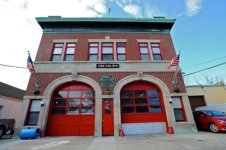
Overview
Station #2 was built in 1923.
Apparatus
This station houses an engine, ladder, and the Department's squad support unit.
Staff
Approximately 28 firefighters and officers are assigned in four shifts to this station.
Westchester Special Operations Task Force
The New Rochelle Fire Department operates one of six squad companies in lower Westchester as part of the Westchester Special Operations Task Force (WSOTF). This task force was developed after the September 11 Terrorist attacks with the goal of training and equipping our members to be able to protect our communities from hazardous materials, weapons of mass destruction (WMD), and other potential effects of terrorism.
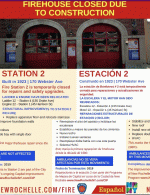
Station #3
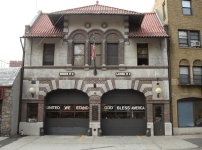
Overview
Station #3 is located in the middle of the City and is first or second responder due to the fact that 75% of the City is in range. Station #3 was built in 1902 and housed two horse drawn units of Olympia Hose Company.
From 1986 to 1987, the house underwent a massive structural renovation including replacement of the apparatus floor, its support system, and the foundation.
Apparatus
This station houses Engine - 23, Ladder - 13, an ALS ambulance (30A2), and a Mask Service Unit.
Staff
Approximately 24 firefighters and officers are assigned in four shifts to this station.
Station #4
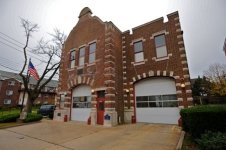
Overview
Station #4 was built in 1911 and was originally designed to house a steamer, hose cart, and five horses as part of Neptune Engine Company. In 1991 a major renovation added an additional apparatus bay, individual dorm rooms, generator, and all new mechanics.
Apparatus
Station #4 houses a single engine company (Engine - 24), a spare engine, and an MCI (Mass Casualty Incident) unit along with a medical gator and trailer (used to provide EMS in crowd areas).
Staff
Station #4 houses 16 firefighters and officers assigned to four shifts.
Station #5
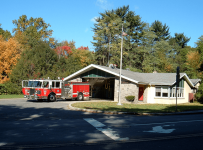
Overview
Station #5 is a single company fire house located at the intersection of Stratton Road and Pinebrook Boulevard. It was built in 1960 when the housing development in this section of New Rochelle became substantial.
Apparatus
The station utilizes Engine 25, Utility 96, and our Fire Safety House trailer.
Staff
This station is staffed by 16 firefighters and officers assigned to four shifts.

APPARATUS
Fire Headquarters (Administrative Offices)
Car 2301 (Commissioner) - 2019 Chevrolet Suburban 4x4Car 2304 (Deputy Chief) - 2007 Chevrolet Suburban 4x4 (Ex-Car 2304, ex-Car 2302)
Car 2305 (Support Services) - 2016 Ford Escape
Car 2306 (Training Unit) - 2009 Ford Crown Victoria
Car 2307 (Fire Marshal) - 2016 Ford Focus
Car 2308 (Safety Officer) - 2016 Ford Escape
Car 2309 (Safety Officer) - 2007 Ford
Car 23010 (Fire Investigation Unit) - 2007 Chevrolet Suburban 4x4 (Ex-Car 2302)
Car 23011 (Fire Prevention Unit) - 2008 Ford Taurus
Car 23012 - 2005 Ford
Fire Station 1
Engine 21 - 2017 Spartan Gladiator Classic LFD / Smeal (1500/500)

Engine 21 (E-21) is the busiest unit in the City responding to over 2,600 runs last year. E-21 is staffed with a fire officer and three firefighters and is currently assigned a 2007 Spartan/Smeal 1500gpm pumper.
Tower Ladder 11 - 2017 Spartan ERV Gladiator Classic MFD (2000/-/93' mid-mount platform)

Tower Ladder 11 (TL-11) is the largest and most expensive apparatus in the New Rochelle Fire Department (NRFD) fleet. Its bucket can reach up to about eight floors to provide a stable work platform for firefighters and fire victims. Last year TL-11 responded to 1,168 emergencies. TL-11 is staffed with a fire officer (captain or lieutenant) and three firefighters and is currently assigned a 2000 Spartan/LTI 95-foot, mid-mount tower ladder with a 1500gpm pump. A replacement unit is on order from Spartan EV and is expected to be in-service in early 2017.
Rescue 4 (Special Operations Unit) - 2009 Spartan Gladiator Classic LFD 6x4 / SVI walk-around w/ crane
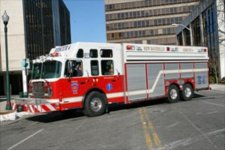
Rescue 4 (R-4) is a 2009 with a Super Vac / Spartan heavy rescue. It was placed in-service at the end of January 2010. Rescue 4 is basically a giant tool box on wheels, carrying equipment to handle auto extrication, water rescue, confined space rescue, high angle rescue, and machinery extrications. R-4 is not staffed, but all members at Station #1 are trained to operate it. When needed, they either bring it along with either Engine 21 or Tower Ladder 11 or in place of one of those units.
The "new" Rescue 4 is the most advanced Rescue Unit to serve the City of New Rochelle. It has a 4,000 crane mounted on its roof and carries a rescue boat and motor that can be lowered from its roof over the side of a sea wall or with the use of its dolly can be placed on the ground and wheeled to a launching point.
It is also the first fire truck to have a "HIPPO" power unit on it. The Hippo unit powers air and hydraulic tools that can cut thru reinforced concrete and steel, break up concrete, pump 1,600 gallons of water and move dirt up out of a trench. While this is the first fire truck to have it, it has been proven by utility companies and the military, with almost 1,000 units in-service
More than 30% of the cost of this vehicle was paid for with a grant from the U.S. Department of Homeland Security.
Rescue 54 (Collapse Rescue Unit) - 2019 Spartan Metro Star LTD / SVI 20' walk-around collapse rescue (SN#1105)
Mini Attack 31 - 2021 Ford F-450 / Combat Support Systems (600/-/120F/540F/300lbs. PK)
Utility Unit 91 (Support Services Unit) - 2006 Ford F-Super Duty 4x4 (Ex-Car 2305)
Utility Unit 92 (Maintenance Unit) - 2008 Ford F-250 4x4
Car 2300 (Transport Unit) - 2008 Chevrolet Express
Car 2302 (Deputy Chief's Unit) - 2019 Ford F-250 4x4
Car 2303 (Spare Deputy Chief's Unit) - 2014 Ford F-250 4x4 (Ex-Car 2302)
Engine 17 (Spare) - 2011 Spartan Gladiator Classic LFD / Smeal (1500/500) (Ex-Engine 21)
Ladder 14 (Spare) - 2007 American LaFrance Eagle 134 (-/-/110' LTI rear-mount aerial) (Ex-Ladder 13, ex-Ladder 12)
Fire Station 2
Engine 22 - 2015 Spartan Gladiator Classic LFD / Smeal (1500/500)
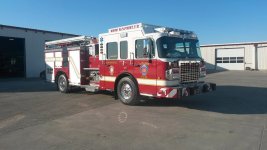
Engine 22 (E-22) is one of our busier units in the City, responding to over 1,850 runs last year. E-22 is staffed with a fire officer (captain or lieutenant) and three firefighters and is currently assigned a 2003 American LaFrance 1500gpm Hazmat / Pumper. It carries special hazmat and WMD equipment found on no other vehicles.
Ladder 12 - 2013 Spartan ERV Gladiator Classic LFD (-/-/103' rear-mount aerial)
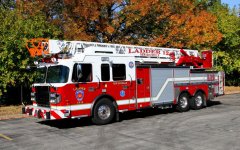
Ladder 12 (L-12) operates a 105-foot rear mount aerial ladder. Last year, L-12 responded to 1,142 emergencies. L-12 is staffed with 3 members made of either a fire officer (captain or lieutenant) and 2 firefighters or 3 firefighters. Ladder 12 is currently assigned a 2007 American LaFrance 105-foot rear mount ladder. Recently, Ladder 12 received a complete set of vehicle extrication tools including hydraulic spreaders, cutters, mechanical rams, and high pressure air bags.
Squad Support Unit 2 - 2017 Chevrolet / Morgan
Fire Station 3
Engine 23 - 2014 Spartan Gladiator Classic LFD / Smeal (1500/500)
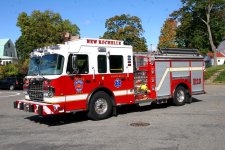
Engine 23 (E-23) responded to 2,090 runs last year. E-23 is staffed with a fire officer (captain or lieutenant) and two firefighters. Engine 23 is currently assigned a 2013 Spartan/Smeal 1500gpm pumper.
Ladder 13 - 2018 Spartan Gladiator Classic LFD / Smeal (-/-/100' rear-mount aerial) (SN#S217202)

Ladder 13 (L-13) operates a 105-foot rear mount aerial ladder. Last year L-13 responded to 1,190 emergencies. L-12 is staffed with three members made up of either a fire officer (captain or lieutenant) and two firefighters or three firefighters. Ladder 13 is currently assigned a 2007 American LaFrance 105-foot rear mount ladder. This vehicle was formerly assigned as Ladder 12. Ladder 13 also carries a complete set of vehicle extrication tools including hydraulic spreaders, cutters, and mechanical rams and high-pressure air bags.
Mask Service Unit 3 - 2006 Ford F-550 / Emergency Apparatus air cascade unit
Last edited:
NEW ROCHELLE
Fire Station 4
Engine 24 - 2017 Spartan Gladiator Classic LFD / Smeal (1500/500)
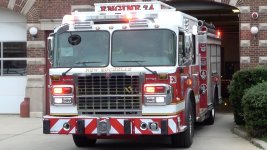
Engine 24 (E-24) responded to over 1,500 runs last year. E-24 is staffed with a fire officer (captain or lieutenant) and two firefighters. Engine 24 is currently assigned a 2004 American LaFrance 1500gpm pumper. This unit was formerly assigned as Engine 22. A new engine is on order and is expected to be in-service by spring 2017.
Mass Casualty Incident Unit 30-U-1 - 2010 Isuzu / American Body Company
Engine 19 (Spare) - 2008 Pierce Arrow XT (1500/750) (SN#21344) (Ex-Engine 25)
Engine 25 - 2020 Spartan ER Gladiator Classic LFD (1500/750)
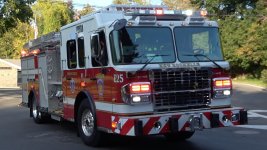
Engine 25 (E-25) is responsible for almost 45% of the City. It is the first response engine company for the homes and businesses from Quaker Ridge Road north to the northern City border. Engine 25 responded to over 900 runs last year. E-25 is staffed with a fire officer (captain or lieutenant) and three firefighters. Engine 25 is currently assigned a 2008 Pierce Arrow 1500gpm pumper.
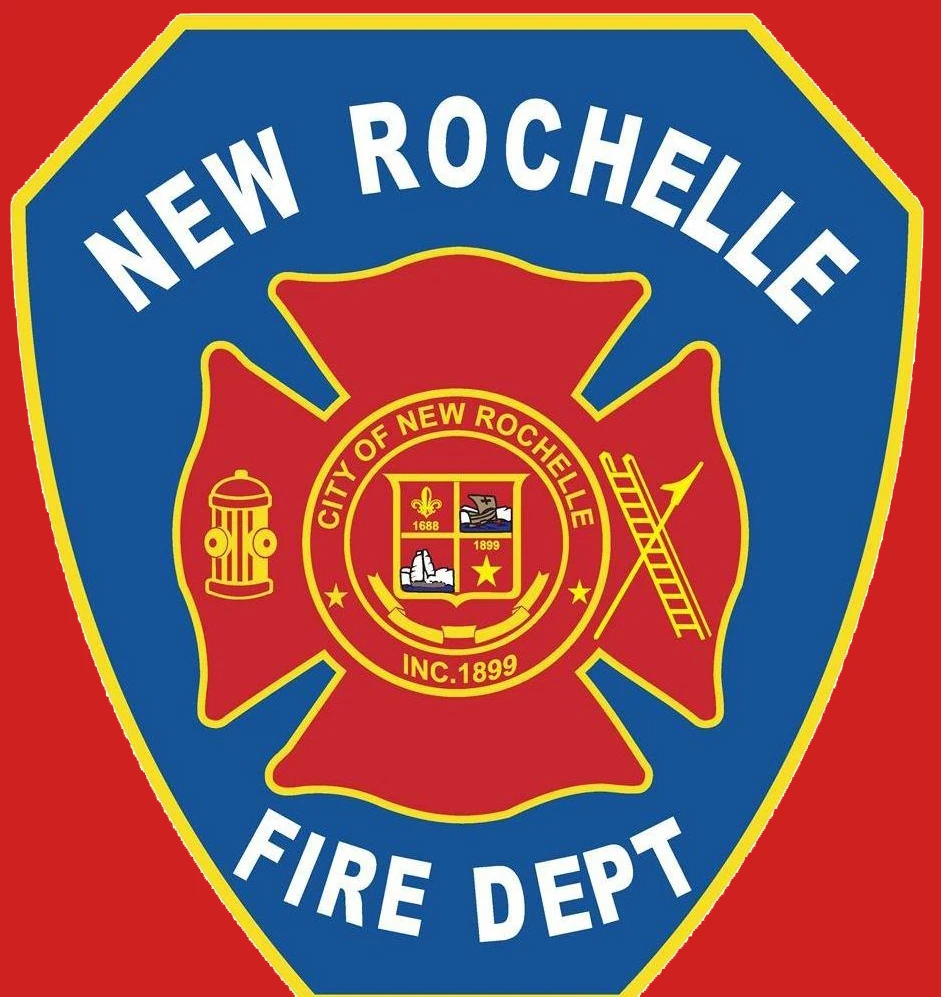
 fire.fandom.com
fire.fandom.com
 www.newrochelleny.com
www.newrochelleny.com
The Support Services Division is headed by a Deputy Chief and is responsible for everything that is not handled by the field companies. It is divided into the following divisions:
Fleet Maintenance Division
Responsible for maintaining the apparatus, staff vehicles and firefighting hose and tools. The department operates with a Master Fire Mechanic and a Mechanic. The department maintenance “Shop” is located behind station #1.
Training Division
Responsible for all training conducted by the New Rochelle Fire Department This training can be academic, (in the classroom) or hands on (in the field). This training is to better prepare our firefighters for the numerous types of emergencies that we are called upon everyday to mitigate. This training starts in “probie” or recruit school.
Safety Division
Responsible for protecting our most valuable asset - our firefighters. The Safety Division’s major role is making sure that all federal and state safety regulations are adhered to. This includes required medical evaluations and treatment from job related injuries, investigating accidents and making corrective action recommendations and performing required annual equipment testing on hose and breathing apparatus. The Safety Division is also responsible for maintenance, repair and replacement of personnel protective equipment.
Office of Emergency Management (OEM)
Responsible for developing plans for responding to, recovering from, and in some instances mitigate the results of natural, technical and man-made disaster events. OEM works closely with the City Manager’s Office, FEMA, SEMO (New York State), Westchester County OEM and the Red Cross.
Emergency Medical Service (EMS) Office
Responsible for the initial and continues Emergency Medical Technician (EMT) training and certification of all fire fighters. All NRFD fire fighters must recertify their EMT every 3 years. The EMS office is also the liaison between the fire department and New Rochelle’s Paramedic Ambulance Service, which is provided by Transcare Ambulance.
The Support Services Division is also responsible for purchasing all equipment and vehicles and working with other agencies to ensure that fire stations are maintained. The Support Services Division develops and administers all federal and state grants to the fire department. Since 2000 these grants have supplied the city with $2.8 million dollars to improve emergency services.
 www.newrochelleny.com
www.newrochelleny.com
Fire Station 4
Engine 24 - 2017 Spartan Gladiator Classic LFD / Smeal (1500/500)

Engine 24 (E-24) responded to over 1,500 runs last year. E-24 is staffed with a fire officer (captain or lieutenant) and two firefighters. Engine 24 is currently assigned a 2004 American LaFrance 1500gpm pumper. This unit was formerly assigned as Engine 22. A new engine is on order and is expected to be in-service by spring 2017.
Mass Casualty Incident Unit 30-U-1 - 2010 Isuzu / American Body Company
Engine 19 (Spare) - 2008 Pierce Arrow XT (1500/750) (SN#21344) (Ex-Engine 25)
Fire Station 5
Engine 25 - 2020 Spartan ER Gladiator Classic LFD (1500/750)

Engine 25 (E-25) is responsible for almost 45% of the City. It is the first response engine company for the homes and businesses from Quaker Ridge Road north to the northern City border. Engine 25 responded to over 900 runs last year. E-25 is staffed with a fire officer (captain or lieutenant) and three firefighters. Engine 25 is currently assigned a 2008 Pierce Arrow 1500gpm pumper.

New Rochelle Fire Department
The New Rochelle Fire Department (NRFD) protects the City of New Rochelle, which has a population of approximately 80,000 residents in an area of about 13 square miles (directly north of New York City). It is comprised of the following units: 5 Firehouses 5 Engine Companies (21, 22, 23, 24, 25)...
Apparatus - Station #1 | New Rochelle, NY
Support Services
Support Services DivisionThe Support Services Division is headed by a Deputy Chief and is responsible for everything that is not handled by the field companies. It is divided into the following divisions:
Fleet Maintenance Division
Responsible for maintaining the apparatus, staff vehicles and firefighting hose and tools. The department operates with a Master Fire Mechanic and a Mechanic. The department maintenance “Shop” is located behind station #1.
Training Division
Responsible for all training conducted by the New Rochelle Fire Department This training can be academic, (in the classroom) or hands on (in the field). This training is to better prepare our firefighters for the numerous types of emergencies that we are called upon everyday to mitigate. This training starts in “probie” or recruit school.
Safety Division
Responsible for protecting our most valuable asset - our firefighters. The Safety Division’s major role is making sure that all federal and state safety regulations are adhered to. This includes required medical evaluations and treatment from job related injuries, investigating accidents and making corrective action recommendations and performing required annual equipment testing on hose and breathing apparatus. The Safety Division is also responsible for maintenance, repair and replacement of personnel protective equipment.
Office of Emergency Management (OEM)
Responsible for developing plans for responding to, recovering from, and in some instances mitigate the results of natural, technical and man-made disaster events. OEM works closely with the City Manager’s Office, FEMA, SEMO (New York State), Westchester County OEM and the Red Cross.
Emergency Medical Service (EMS) Office
Responsible for the initial and continues Emergency Medical Technician (EMT) training and certification of all fire fighters. All NRFD fire fighters must recertify their EMT every 3 years. The EMS office is also the liaison between the fire department and New Rochelle’s Paramedic Ambulance Service, which is provided by Transcare Ambulance.
The Support Services Division is also responsible for purchasing all equipment and vehicles and working with other agencies to ensure that fire stations are maintained. The Support Services Division develops and administers all federal and state grants to the fire department. Since 2000 these grants have supplied the city with $2.8 million dollars to improve emergency services.
Support Services | New Rochelle, NY
Last edited:
NEW ROCHELLE
History
Thanks to a $2,400 appropriation in 1861 by the village fathers, New Rochelle's first fire company -- known as the Enterprise Hook and Ladder and Bucket Company No. 1 -- was organized. Half the money paid for a hook and ladder, $400 for other equipment, and $800 for a firehouse. Shortly after, another group of citizens began to organize an independent fire company known as Huguenot Company No. 1, which became the first company to get its apparatus ahead of Enterprise.With this, the history of the New Rochelle Fire Department began, but the early days of fire fighting were not easy. Both companies had ladders, but no hoses. Neither had an engine to pump water. And, access to water was scarce.
The late 1800s saw many other volunteer fire companies form as well the introduction of a hand pumping fire engine formerly used by the New York City Fire Department. In effect, this was the dawn of the modern era of fighting fires.
Shortly after the turn of the century, $50,000 was appropriated to fully modernize the department and set in motion the transition from a volunteer force to a paid 1. The monies were used for new a fire headquarters and the hiring of the first 2 paid firemen to drive the new equipment.
The late '20s saw the last of the volunteer firemen and by 1929, there were 99 paid firemen in the department.
The '30s, '40s and '50s were marked by continued modernization, but just as importantly, the department focused on fire prevention and received national recognition for its efforts. In the midst of all this, the department had to reach back to the days of volunteers. With the outbreak of World War II, many of the men who served in the department went to fight, and many of the positions in the department were filled by an auxiliary force.
The '60s and '70s saw the creation of the Emergency Reporting System, the movement of the fire headquarters to City Hall, the replacement of all of the City's fire apparatus, and heavy emphasis on mobile inspections and fire prevention. The early '80s were marked by major steps in the emergency medical field with the introduction of EMT classes for firefighters and great improvement in the medical equipment on fire apparatus.
Today's Fire Department is a full service department, capable of handling fires, rescues, extrications, and hazardous material incidents. The department aggressively pursues fire prevention and code enforcement programs, and is responsible for plan reviews, underground tank installations, and control of all places of public assembly. The department also issues licenses and permits in an effort to control potentially hazardous or even dangerous situations.
Keeping buildings and other living areas in good, safe condition is a major responsibility of the department. By controlling illegal, dangerous occupancies and tenant overcrowding residents are kept safe.
The New Rochelle Fire Department is known as the premiere fire department in the area because of its wide range of services and its professionally trained staff. And, with 5 fire houses strategically stationed throughout the City, when a fire breaks out, or if there's a medical emergency or disaster, help is only a short distance away.
History | New Rochelle, NY
